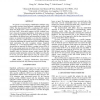Free Online Productivity Tools
i2Speak
i2Symbol
i2OCR
iTex2Img
iWeb2Print
iWeb2Shot
i2Type
iPdf2Split
iPdf2Merge
i2Bopomofo
i2Arabic
i2Style
i2Image
i2PDF
iLatex2Rtf
Sci2ools
ICASSP
2010
IEEE
2010
IEEE
Language recognition using deep-structured conditional random fields
We present a novel language identification technique using our recently developed deep-structured conditional random fields (CRFs). The deep-structured CRF is a multi-layer CRF model in which each higher layer’s input observation sequence consists of the lower layer’s observation sequence and the resulting lower layer’s frame-level marginal probabilities. In this paper we extend the original deep-structured CRF by allowing for distinct state representations at different layers and demonstrate its benefits. We propose an unsupervised algorithm to pre-train the intermediate layers by casting it as a multi-objective programming problem that is aimed at minimizing the average frame-level conditional entropy while maximizing the state occupation entropy. Empirical evaluation on a seven-language/dialect voice mail routing task showed that our approach can achieve a routing accuracy (RA) of 86.4% and average equal error rate (EER) of 6.6%. These results are significantly better than th...
Related Content
| Added | 06 Dec 2010 |
| Updated | 06 Dec 2010 |
| Type | Conference |
| Year | 2010 |
| Where | ICASSP |
| Authors | Dong Yu, Shizhen Wang, Zahi Karam, Li Deng |
Comments (0)

